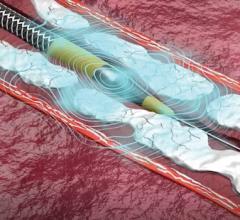
May 15, 2019 — W. L. Gore & Associates Inc. (Gore) announced the U.S. Food and Drug Administration (FDA) has granted regulatory approval for commercial distribution of the Gore Tag Conformable Thoracic Stent Graft with Active Control System. The device is a thoracic endovascular aortic repair (TEVAR) solution combining new levels of control with the performance of the Conformable Gore Tag Device. The device and delivery system provide new precision and predictable patient outcomes in the endovascular repair of aneurysms, transections and Type B dissections of the descending thoracic aorta. A smaller-diameter primary delivery sleeve gives the device and system a lower profile across 10 device sizes.
The Gore Active Control System provides controlled, two-stage deployment, with primary deployment to an intermediate diameter and a secondary deployment to full diameter. This design allows for continuous blood flow throughout the deployment, with multiple opportunities to visualize and refine graft placement. It is also designed to allow for angulation of the proximal end of the device for improved seal and apposition. It gives physicians added precision in placement and angulation so they can take full advantage of the conformability of the Gore device and confidently provide a minimally-invasive solution to more patients.
No change was made to the stent graft itself, which has demonstrated long-term freedom from device-related reintervention (93.1 percent) and low complication rates (zero migrations, fractures or compressions). Large device oversizing windows were engineered, tested and proven to accommodate differences in proximal and distal landing zone diameters; a 6-33 percent oversizing window allows physicians to choose the optimal radial force to fit patient anatomy and etiology, whether treating a young trauma patient or a fragile dissected aorta. The 16-42mm range can be treated with as few as five sizes, allowing providers to stock fewer devices while treating a broader range of patients.
For more information: www.gore.com


 November 14, 2025
November 14, 2025 









